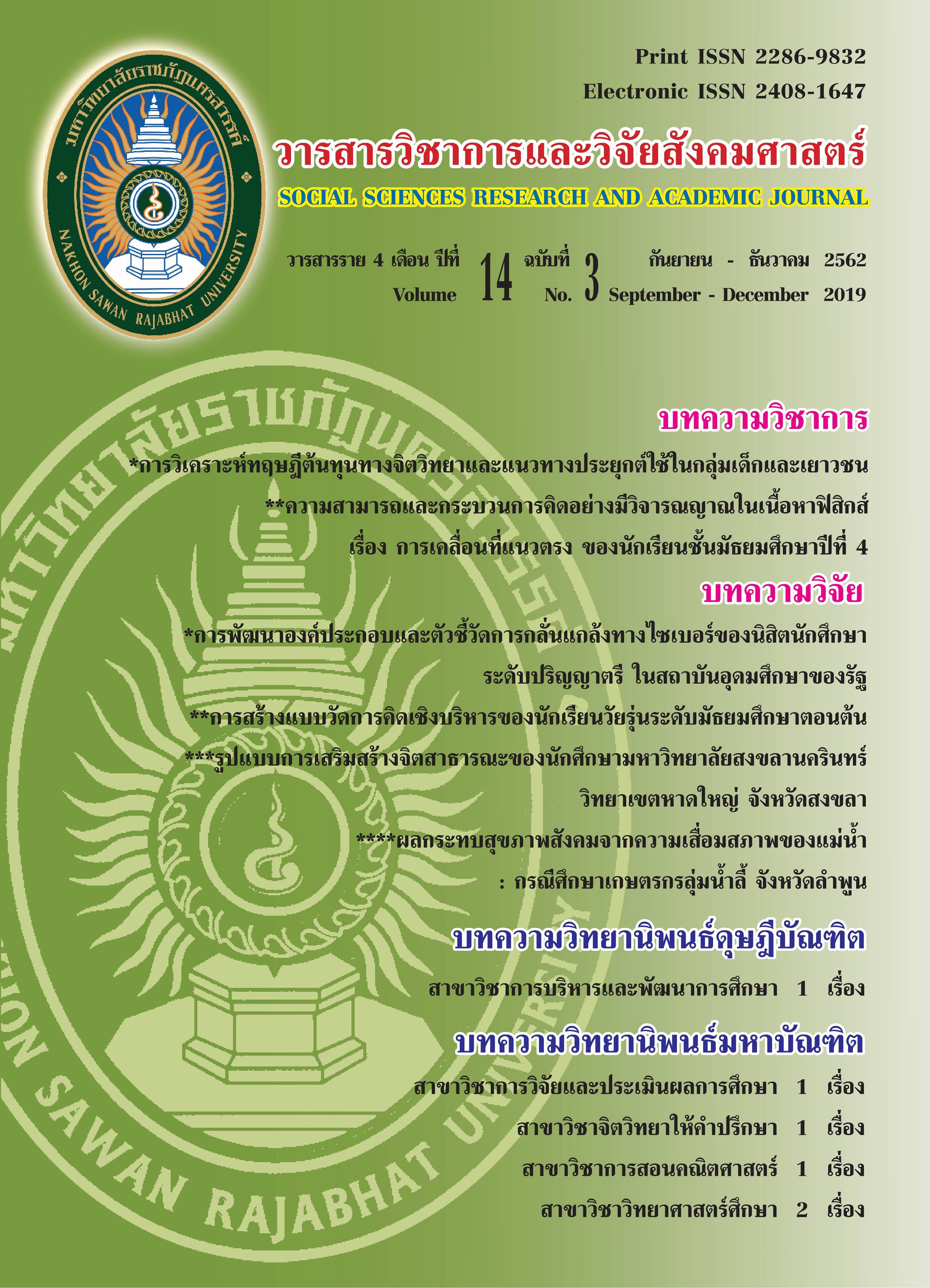การพัฒนาแบบวัดการคิดอย่างมีวิจารณญาณในสาระวิทยาศาสตร์ สำหรับนักเรียนระดับชั้นมัธยมศึกษาปีที่ 4 สังกัดสำนักงานเขตพื้นที่การศึกษามัธยมศึกษา เขต 1 (กรุงเทพมหานคร) The Development of Critical Thinking in Science Test for Mathayomsuksa 4 Students Under the Secondary Educational Service Area Office 1 (Bangkok)
Main Article Content
Abstract
การวิจัยครั้งมีวัตถุประสงค์เพื่อ 1) สร้างแบบวัดการคิดอย่างมีวิจารณญาณในสาระวิทยาศาสตร์ สำหรับนักเรียนระดับชั้นมัธยมศึกษาปีที่ 4 สังกัดสำนักงานเขตพื้นที่การศึกษามัธยมศึกษา เขต 1 (กรุงเทพมหานคร) 2) ตรวจสอบคุณภาพของแบบวัดการคิดอย่างมีวิจารณญาณในสาระวิทยาศาสตร์ 3) สร้างเกณฑ์ปกติระดับท้องถิ่นของแบบวัดการคิดอย่างมีวิจารณญาณในสาระวิทยาศาสตร์ และ 4) สร้างคู่มือการใช้แบบวัดการคิดอย่างมีวิจารณญาณในสาระวิทยาศาสตร์ กลุ่มตัวอย่างที่ใช้ในงานวิจัยครั้งนี้คือ นักเรียนที่กำลังศึกษาอยู่ระดับชั้นมัธยมศึกษาปีที่ 4 ปีการศึกษา 2560 ของโรงเรียนสังกัดสำนักงานเขตพื้นที่การศึกษามัธยมศึกษา เขต 1 (กรุงเทพมหานคร) จำนวน 712 คน ได้จากการสุ่มแบบ 2 ขั้นตอน
ผลการวิจัยพบว่า แบบวัดการคิดอย่างมีวิจารณญาณในสาระวิทยาศาสตร์ที่สร้างขึ้นจำนวน 32 ข้อ ประกอบด้วย 4 องค์ประกอบ ได้แก่ การระบุประเด็นที่สำคัญ การพิจารณาเหตุผล การประเมินข้อเท็จจริง และการตัดสินใจ โดยองค์ประกอบที่ 1 2 และ 3 เป็นแบบเลือกตอบ และองค์ประกอบที่ 4 เป็นแบบตอบสั้น ผลการตรวจสอบคุณภาพของแบบวัดมีค่าดัชนีความสอดคล้องระหว่างข้อคำถามกับนิยามการคิดอย่างมีวิจารณญาณในสาระวิทยาศาสตร์แต่ละองค์ประกอบอยู่ระหว่าง 0.4 - 1.0 ค่าความยาก ตั้งแต่ 0.20 - 0.79 ค่าอำนาจจำแนก ตั้งแต่ 0.25 - 0.96 ค่าความเที่ยง เท่ากับ 0.65 มีความตรงเชิงโครงสร้าง (χ2= 782.999, df = 413, p =.06, χ2/df = 1.896, RMR = .036, RMSEA = .048, GFI = .909 และ CFI = .680) ค่าน้ำหนักองค์ประกอบแต่ละข้อคำถามระหว่าง -0.079 - 0.682 เกณฑ์ปกติของแบบวัดมีค่าตั้งแต่ T20 ถึง T91 และคู่มือการใช้แบบวัดการคิดอย่างมีวิจารณญาณในสาระวิทยาศาสตร์มีรายละเอียดครบถ้วน สามารถนำไปใช้ได้อย่างเหมาะสม
The purpose of this research were 1) to construct the Development of Critical Thinking in Science Test for Mathayomsuksa 4 Students under the Secondary Educational Service Area Office 1 (Bangkok).; 2) to validate the Development of Critical Thinking in Science Test; 3) to establish grade norms of the Development of Critical Thinking in Science Test; and 4) to construct the manual of the the Development of Critical Thinking in Science Test. All samples were Mathayomsuksa 4 students who studied in schools under the Secondary Educational Service Area Office 1 (Bangkok) in the academic year 2017. Data were collected from 712 samples using two stage random sampling.
The research results revealed that: Critical Thinking in Science Test for Mathayom suksa 4 Students consist of 4 elements: getting the point, seeing the reason, evaluation of fact and decisions. There are 8 questions in each element, including the number of all are 32 questions. Each question in element of getting the point, seeing the reason and evaluation of fact consists of 4 multiple choices and element of decisions is opened ended question. The analysis showed that the Item Objective Congruence Index between 0.4-1.0, item difficulty between 0.20-0.79, item discrimination between 0.25-0.96 and item reliability was 0.65. The construct validity of the measure of forgiveness was quite well (χ2= 782.999, df = 413, p =.06, χ2/df = 1.896, RMR = .036, RMSEA = .048, GFI = .909 and CFI = .680) Factor loading in each question was between 0.089-0.615. This is norm referenced for the whole test was between T20-T91. This manual can be used for the measuring critical thinking skills in science with completely details and can be applied appropriately and practically.
Article Details
References
ชวาล แพรัตกุล. (2552). เทคนิคการวัดผล. (พิมพ์ครั้งที่ 7). กรุงเทพฯ: มหาวิทยาลัยศรีนครินทรวิโรฒ.
ทิศนา แขมมณี. (2544). วิทยาการด้านการคิด. (พิมพ์ครั้งที่ 1). กรุงเทพฯ: เดอะมาสเตอร์กรุ๊ป แมเนจเม้นท์.
ราตรี นันทสุคนธ์. (2553). หลักการวัดและประเมินผลการศึกษา. กรุงเทพฯ: จุดทอง.
สุวิมล แสงศรี. (2550). กิจกรรมพัฒนาการคิดอย่างมีวิจารณญาณทางวิทยาศาสตร์ของนักเรียนชั้นมัธยมศึกษาปีที่ 3. วิทยานิพนธ์ศิลปศาสตรมหาบัณฑิต (สาขาศึกษาศาสตร์การสอน). มหาวิทยาลัยเกษตรศาสตร์, กรุงเทพฯ.
สัญญลักษณ์ สวัสดีมงคล. (2549). การคิดอย่างมีวิจารณญาณทางวิทยาศาสตร์ ของนักเรียนชั้นมัธยมศึกษาปีที่ 3 เขตพื้นที่การศึกษากรุงเทพมหานคร เขต 2. วิทยานิพนธ์ศิลปศาสตรมหาบัณฑิต (สาขาศึกษาศาสตร์การสอน). มหาวิทยาลัยเกษตรศาสตร์, กรุงเทพฯ.
Fraser, B.J. (1980). Development And Validation Of A Test Of Enquiry Skills. Journal Of Research In Science Teaching, 17 (1), 7-16.
Faul, F., Erdfelder, E., Buchner, A., and Lang, A.-G. (2009). Statistical power analyses using G*Power 3.1: Tests for correlation and regression analyses. Behavior Research Methods. 41, 1149-1160. Download PDF.
Paul, R., and Elder, L. (2007). The Miniature Guide to Critical Thinking Concepts and Tools. Retried July 8, 2014, from www.criticalthinking.org
Watson, G., and Glaser, E. M. (2012). Critical Thinking Appraisal User-Guide and Technical Manual. UK: NCS Pearson.


